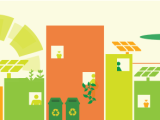It’s a milestone for anyone: 30 years!
And this year, on September 16th as we mark the 30th anniversary of the Vienna Convention for the Protection of the Ozone Layer, we have more to celebrate than ever before.
Also known as International Day for the Preservation of the Ozone Layer, September 16th will be a day to celebrate the collective efforts of protecting the ozone layer over the past three decades. According to the United Nations, as a result of these global efforts, the ozone layer that protects life on Earth from harmful UV radiation is in fact, healing itself and expected to recover by the middle of the century.
So this means what we do - every day - to help the planet is actually working.
The Ozone Layer is a natural part of our atmosphere that acts like a protective sunscreen or blanket by blocking harmful ultraviolet rays from the sun. In 1974, scientist revealed that man-made chlorofluorocarbons (CFCs) were harming the Ozone Layer. More research was conducted and finally, in 1985, the Vienna Convention was signed on September 16. This led to the Montreal Protocol, an international treaty designed to phase out the production of numerous substances that are harmful to the ozone.
After 30 years of work, the UN says that within the next 15 years up to 2 million case of skin cancer may have been prevented and significant adverse effects on agriculture, wildlife, fisheries and materials have been avoided, as well.
While we’ve made great strides on our way towards saving this remarkable resource, we aren’t 100% in the clear. Nor are we off the hook for other human activities that adversely impact the atmosphere of the earth. Which is why this celebration is an important reminder to keep doing everything we can to lighten our footprint on the earth. As the EPA reports, carbon dioxide emissions (the main pollutants that are warming Earth and causing climate change) are on a continuing rise. According to the EPA, fossil fuel emissions have increased by over 16 times between 1900 and 2008 and by about 1.5 times between 1990 and 2008.
While carbon dioxide is emitted naturally when living things breathe, it is also released as a pollutant during human activities that involve the burning of fossil fuels such as gasoline and natural gas. In 1988 we surpassed the safety limit level for atmospheric CO2 which is 350 parts per million. Human activities create more heat-trapping gases and increase the earth’s temperature every year. The resulting global warming is the cause of climate-change indicators that make the earth less inhabitable. Scientists predict that global warming will cause a strong increase in the conditions that create extreme weather events over the next century.
The textile industry, a huge producer of greenhouse gasses, contributes to 10 percent of the world’s carbon and is the 5th largest contributor to CO2 emissions in the United States. As sustainable fabric makers O EcoTextiles explains, to create raw materials for yarn to create textiles, huge quantities of fossil fuels are required - both to create energy directly needed to power mills, produce heat and steam, as well as indirectly to create the many chemicals used in material production phase. Additionally, they note, the textile industry is amongst lowest efficiencies in energy utilization because it’s largely antiquated. To put it into perspective, they say, it requires less gasoline (energy) to drive a Lamborghini from New York to Washington D.C. than it does to produce 25 yards of nylon fabric.
In order to make a difference, most people agree that a variety of measures need to be taken.
Just like the work that was done for the Ozone Layer; reducing CO2 requires a concerted global effort by citizens and industry. The solution lies in individual and common commitment to sustainable living.
While we work together, it’s important to keep the big picture in mind. In addition to taking individual actions, you can encourage your community and local businesses to go green. At USAgain, our mission to help communities go green couldn’t happen without the support of concerned citizens like you.
Here are 3 ways that you can make a green difference in your community with little effort:
- Support the business that offer recycling opportunities
Consumers love convenience and are increasingly favoring corporate responsibility, which is why more businesses are implementing eco-friendly practices, and making formerly inaccessible recycling options available within their facilities. From plastic bags to batteries to clothing and shoes, businesses support the collection of recycled materials. Do your research in advance to find businesses near you where you can recycle? You can click here to find our list of businesses that provide USAgain clothing recycle bins.
- Ask your city or local business to host a textile-recycling box.
While it’s true that recycling does cost money, as does all waste disposal. Municipalities and businesses can partner up with recycling providers who cover collection and pick up costs. If you’d like to see more recycling, tell your favorite stores to host clothing recycling bins.
- Hold a Greenraiser
Our Greenraiser programs are helping schools transform surplus clothing and shoes from trash into cash. We supply and service a collection bin to participating schools, while they also get paid for every pound recycled. While learning about their environmental footprint, students are able to recycle unwanted clothing and shoes in an effort that amounts to extra cash for their school. Our efforts come at no cost to you. All you need is the passion (and approval for us to bring a textile bin to your event or building. We’ll arrange for all work costs involved.
